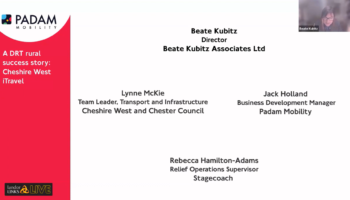
When reading claims that DRT software x has achieved better results than software y, it’s important to look at the context. That’s why I have been looking at the metrics we should be measuring to determine the efficacy of a DRT system – and contextualise it within the wider network. You can download my paper for the Transport Practitioners’ Meeting here.
Whilst it’s great that the DfT launched the Rural Mobility Fund (RMF) to trial DRT outside of urban areas, it’s also rather disingenuous to compare rural DRT with urban schemes and seek the same ridership or indeed cost per passenger. Rural transport is notoriously difficult and subsidies can be eyewatering for both timetabled and on-demand services. Just to give you an idea of the variation in passenger numbers, the total average occupancy for all buses across rural and urban areas in England (outside London) is 10.1 passengers. Which means that for every packed double decker there are a lot of buses running with very very few people on them.
Rural characteristics
The RMF schemes typically run over several hundred square kilometres – and with population densities around 2-400 people per km2. In general, the less dense a population is, the harder and more expensive it is to deliver services – and this is particularly marked for transport. In fact, for of all local authority services, transport correlates most strongly with increased costs due to population[1].
In addition, rural areas are also most car dependent at the launch of the schemes. They have typically had poor to no bus services for some time. And while people who do not drive have few options, the majority of the population has become habituated to driving everywhere.
Comparing RMF schemes with each other should be benchmarked to the area’s population density. Data suggests that there is a discernable correlation between population density and efficiency (measured in passengers per vehicle hour).
Schemes successfully delivering several passengers per hour in low density areas are operating more efficiently than schemes with similar passenger trips per hour drawn from denser populations. Other metrics checking on the passenger experience and the overall availability of transport are also important to ensure that the service is useful as part of public transport – for instance whether people are able to book the trip they want and how far they have to walk to get to a service that runs to where they need to go at the time needed.
In the UK, schemes using the Padam Mobility platform are rural schemes in areas of low population density. The trips people make are typically longer and the demand for travel more variable. This is challenging for services operating across larger areas. The bus may have to travel some distance to pick up passengers – and with lower population numbers and density, it’s less likely that there will be someone travelling in that direction. Despite this we see rates of 3 trips per vehicle hour in some particularly well-marketed schemes. Other schemes for which we have data are now also markedly better than the best reported passengers per vehicle hour collated in the Rural Mobility Fund Evaluation Interim Report in June 2023.
Urban areas are different. With denser populations it is easier to deliver transport services of all kinds – from rapid transit systems to bike share – and this is true for DRT too.
In urban areas such as Orleans in France we see 400,000 trips per year on a system with low public subsidies. The Orleans Metropole area has a population of 288,000 (although the scheme largely runs over the outlying areas, about 177,000 people) and a population density of 862 people per km2 across the whole of the metropolitan area. The typical number of passengers per vehicle hour in Orleans 4.34.
This is comparable to Milton Keynes – which has a similar population (264,000) and a population density of 960 people per km2. All subsidized bus services are provided by DRT across the city centre (although excluding people who could travel on high frequency bus lines) and the local authority has published a passenger per vehicle hour of 3.1 (the operating platform Via claims ‘just under 4’[2] passengers per vehicle hour).
Whilst this represents substantial savings for both cities it is not helpful to compare it with rural schemes with lower population densities, longer trips between homes, services and other destinations
| Scheme | Rural classification | Population density (people per km2) | Average trip length (miles) | Passengers per vehicle hour |
| Cheshire West | Urban with significant rural (the iTravel DRT runs over rural zone) | 388 | 6.42 | 3 |
| Milton Keynes | Urban with city and town | 960 | 5 | 3.1 |
Finding Benchmarks for services is something we need to do. These need to include understanding who is currently un-served and underserved by public transport, where spending needs to be targeted to improving the equality and economic prospects of the UK.


At the same time, benchmarks on what that spending is achieving are also important. However, these benchmarks need to be context dependent – we have long understood that urban and rural populations require different approaches and have different costs for service delivery.
DRT is no different. There is no ‘one size fits all’ solution. We need to be realistic about how we serve urban and rural populations, the metrics we expect and what it will cost – and how that will differ in different topographies.
One of the key things that has come out of investigating metrics for DRT is that we need much more specific and granular data to really understand local contexts and compare DRT schemes with each other and with the rest of the network.
Table Sources:
ONS Open Geography Portal 2011 Rural-Urban Classification of Local Authority Districts and Similar Geographic Units in England
ONS census maps for LADs of North Hertfordshire, Cheshire West and Chester, Forest of Dean and Milton Keynes
Cheshire West iTravel Webinar 20 May 2024 https://youtu.be/7zyIVNfsD2s?si=6G15xj85FJ9Q6Brm
Milton Keynes Council DRT data: https://www.milton-keynes.gov.uk/media/6093/download?inline
[1] https://assets.publishing.service.gov.uk/media/5a7e51e840f0b6230268a97c/Rural_summary_report.pdf
[2] Via advert https://ridewithvia.com/resources/better-drt-technology-is-just-the-beginning.-integrating-tech-and-operations-is-the-next-frontier-for-cost-effective-services?li_fat_id=5aa1adfa-4642-4486-94b5-ffb4b24f3325&utm_medium=paidsocial&utm_source=linkedin&utm_campaign=UK+-+ToF+-+Single+Image+Ads&hsa_acc=506606589&hsa_cam=679477293&hsa_grp=267931276&hsa_ad=454734693&hsa_net=linkedin&hsa_ver=3&trk=ad_library_ad_preview_headline_content



